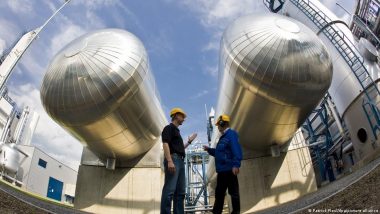Carbon dioxide emissions are building up in the atmosphere and warming our planet. They can be removed and stored out of harm's way, but it isn't cheap. And critics caution against relying on the process as a cure-all.Carbon dioxide is a natural and important part of the Earth's atmosphere. But at about 422 parts per million, or 0.04%, its concentrations are some 50% higher than 200 years ago, at the start of the Industrial Revolution.
Also Read | Business News | Dynamic Cables Reports Highest Ever Revenue on Quarterly and 9 Months Basis.
Since then, human activity — largely the burning of fossil fuels — has boosted this planet-heating gas to dangerous levels, and we've done little to slow those emissions.
As carbon dioxide and other greenhouse gases build up in the atmosphere, they act as a blanket and prevent solar energy from radiating back out into space at night, thereby warming the planet.
What is carbon capture and storage?
Carbon dioxide (CO2) is naturally removed from the atmosphere by forests and other plant life. Oceans and soils also absorb CO2, removing it from the atmosphere. But these aren't quick fixes, and we're rapidly wiping them out through deforestation, pesticide overuse and pollution.
Carbon capture and storage, or sequestration (CCS), can prevent excess carbon dioxide from getting into the atmosphere in the first place. It was first introduced in the 1970s, though the process remains controversial for some due to health and safety concerns.
These include leaking pipes that could cause asphyxiation in humans or animals, drinking-water contamination through leached metals and other pollutants and the potential for seismic activity triggered by the compressed CO2. It remains banned in Germany.
How does carbon capture and storage work?
Point-source capture involves artificially separating CO2 from other gases released by the burning of fossil fuels like coal or natural gas, or from steel mills, refineries, cement and fertilizer plants. CO2 can also be removed from fuel before combustion, but this process uses different technology found in newer facilities.
Once captured, the CO2 is compressed into a liquid and transported to a suitable storage site, usually deep underground. Storage sites can include former oil and gas reservoirs, abandoned coal mines and porous rock formations filled with salty water.
CO2 can be pulled directly from the air using filters and chemicals in a process known as direct air capture with carbon storage, or DACCS. These facilities are energy intensive, and still very expensive.
Another option, bioenergy with carbon capture and storage, or BECCS, involves burning biomass — wood, energy crops or solid agricultural and municipal waste that contains captured carbon — to generate energy. The resulting emissions are captured and stored underground.
Planting and processing managed forests and crops could sequester even more carbon, though these crops could end up competing with food crops for land and water.
The use of all these technologies today is still limited, and mostly untested on a larger scale
Why does carbon capture and storage matter?
Even if we drastically cut carbon dioxide emissions in the near future, the world will still need to remove between 450 billion and 1.1 trillion metric tons of CO2 by 2100, according to a January 2023 expert report.
The UN's Intergovernmental Panel on Climate Change said in 2022 that the use of CO2 removal technologies will be "unavoidable" if the world wants to meet its net-zero emissions goals.
But experts warn the sector will need to see substantial development over the next 10 years. Current research suggests just 0.1% of global emissions are captured by such technology.
In November 2023, the International Energy Agency warned that oil and gas producers needed to "[let] go of the illusion that implausibly large amounts of carbon capture are the solution." And critics point out that CCS technology just gives fossil fuel producers the green light to continue exploiting oil, gas and coal.
A better solution, they say, is to reduce our dependence on fossil fuels and phase them out completely — as soon as possible.
Edited by: Tamsin Walker
(The above story first appeared on LatestLY on Feb 06, 2024 03:20 PM IST. For more news and updates on politics, world, sports, entertainment and lifestyle, log on to our website latestly.com).













 Quickly
Quickly




















